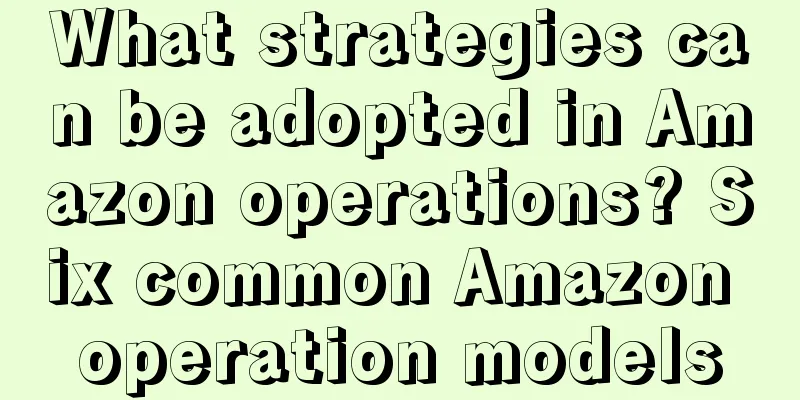Internet Product User Lifecycle Management

Hello everyone, I am Daming. Since ancient times, mankind has never stopped exploring the universe, from microscopic life cells to macroscopic cosmic stars, from the deep ocean to mysterious dark matter and black holes. Although we are still full of unknowns and confusions about the mysteries of cosmic life, in this process, we have gradually comprehended and summarized a series of profound theories about the life cycle. In short, everything has a beginning and an end, just like the birth, aging, sickness and death of people, the blooming and withering of flowers. All things in the universe are performing their own legends in the cycle of life and death. To quote Lao Tzu in the Tao Te Ching: "Tao begets One, One begets Two, Two begets Three, Three begets all things. All things change, but eventually they return to One." This is not only a description of the creation and evolution of all things in the universe, but also a profound interpretation of life and philosophy. To put it simply, "he describes the complete process of a thing from its birth to its death." Today, the life cycle theory has been widely used in many fields such as society, politics, economy, business and technology. Everything in the world is subject to the cycle of life and death. So is there any way to predict the life cycle of Internet products? How can we improve market competitiveness and maximize user value at different stages of the product life cycle? I'll give you three seconds to think. 3, 2, 1 This sounds like a metaphysical question that is difficult to answer. OK, let me tell you the answer first. The answer is: Yes In the field of data analysis, we can actually observe the application of various life cycle theories. These theories not only help us understand the development laws of things more deeply, but also provide us with useful guidance and inspiration in practical work. The topic shared in this issue is two commonly used life cycle management theories in the Internet field, " product growth cycle" and "user life cycle" . The curves of these two cycles are highly similar and can easily be confused. From a literal meaning, one focuses on the product and the other focuses on the user. In actual application, many students blindly study the user life cycle. The product growth cycle focuses on the overall development stage and macro characteristics of the product, from the embryonic stage to the mature stage, and then to the possible decline stage, reflecting the macro indicators such as user scale, growth rate and market share of the product at different stages. The user life cycle focuses more on the behavioral changes and micro-processes of individual users within the product. The main difference lies in its focus and stage division. The two need to be combined when analyzing and applying in order to fully understand the situation of products and users. The "product growth cycle" curve is an inverted S-shaped curve that depicts the complete process of a product from birth to decline. This process is generally divided into four stages: "exploration" , "growth" , "maturity" and "decline" . The number of users in each stage will change significantly with the change of cycles. This curve accurately reflects the fluctuation trend of user volume over time, providing us with a powerful tool to deeply understand the growth trajectory of the product. Products are created based on user needs, but needs are always evolving dynamically. Even if a newly launched product meets temporary needs, it may not necessarily touch the essence of the needs. Therefore, the core goal of a product in the "exploration stage" is to accurately capture user pain points, conduct in-depth functional analysis, and quickly verify and optimize the product through continuous hypothesis, verification, iteration, and execution of PoC , thereby winning user recognition. During the exploration period, we focus on the following aspects: Discover users’ real pain points and needs through in-depth market research or competitive product analysis; Conduct demand analysis based on requirements, understand and verify the extent to which the product solves user problems through MVP , and after completing PoC and MVP , design product prototypes, development, testing and other links based on the minimum viable product to ensure the stability and reliability of the product's basic functions. Glossary:
After careful polishing and iteration, the product has been able to meet the needs of a stable user group and demonstrate good retention capabilities. At this point, the number of users will continue to grow, and the main goal of the product will shift to acquiring more users, realizing conversion and monetization, establishing a brand image, spreading a good reputation, and ultimately reaching the highest profit point in its life cycle. During the "growth stage" , it is necessary to pay close attention to special business indicators and functional scenarios set by users, such as page access data, jump conditions, access duration, and user usage paths, that is, indicators that can allow users to enter the Aha Moment , in order to gain insight into users' real needs and behavior patterns. By continuously optimizing product functions, improving user experience, and strengthening marketing and operational strategies, we strive to promote the sustainable and healthy development of our products and achieve higher market share and profit returns. Glossary:
From the user's perspective, when users download a product, they will start looking for the product's value to them. The moment a user confirms that a product is "useful" , they encounter the Aha moment in the product. The user may or may not be aware of this moment, but in any case, whether the user experiences this moment determines whether he becomes a retained user of the product or a lost user. As the user base expands rapidly, product positioning and user base gradually stabilize, the growth rate of new users gradually slows down, and the activity of old users becomes dominant. At the same time, since the product has met the actual needs of users, competing products have begun to emerge in the market, intensifying the competition for users, resulting in rising costs for acquiring new users and increasing channel delivery costs. The core goal of "mature" products has shifted to how to effectively activate and maintain the existing old user group. The commercialization process has become the focus of attention. The focus of work has gradually shifted from attracting new users, promoting activation, and improving retention rates to reducing user churn rates, implementing user recall strategies, and deeply exploring user value, so as to maintain new user growth at a lower cost and continue to generate stable revenue. When a product enters the "decline stage" , there is relatively limited work that can be done. At this time, we should do our best to slow down the product's decline, actively help the product achieve transformation, deeply explore new needs of existing users, or decide to directly transfer user groups after careful consideration and withdraw from the original competitive market. For products that are in decline, the focus should be on awakening silent users and recalling lost users. Of course, if new growth points can be found, the product may be able to regain its vitality, but this requires not only a certain amount of luck, but also careful strategy and layout. Observing user acquisition from the product growth cycle, there is a significant pattern. In the exploration stage, the product positioning is unclear and the user acquisition cost is high. After entering the growth stage, the positioning is clear and the cost gradually decreases. However, in the mature stage, the market is saturated and competing products are fierce, so the cost of acquiring new customers rises again until the decline stage. It is worth noting that although the costs of the exploration stage and the mature stage are both high, there are obvious differences. The user conversion potential in the exploration stage is large, while the user scale in the mature stage is huge and the competition is fierce. Combined with user life cycle curve analysis, it helps to improve user stickiness and usage time. The "user life cycle" curve is highly similar to the product growth cycle curve. Both of them go through a natural evolution process from gestation to decline. This process is generally divided into five stages: "introduction period", "growth period", "maturity period", "silent period" and "churn period" . Each stage reflects the different states and characteristics of users in the process of using the product, and the operation strategy also has different emphases. In the introduction phase, we focus on new user acquisition strategies to attract users to try our products for the first time. In the growth and maturity stages, more attention is paid to activation and retention strategies, using various means to stimulate user activity and loyalty; When users reach the silent period and churn period, we need to use awakening and recovery strategies to try our best to extend the user's life cycle and reduce churn. "Attracting new users", "promoting activation" and "retention" often mentioned in operations are the three most important operational strategies based on the user's status in these five stages. After users enter the product, they will experience their own growth path. This is a behavioral observation at the micro level, while the user life cycle shows the staged behavior of the user group from a macro perspective. As a product grows, users become more active, but may eventually leave for various reasons, completing the entire life cycle cycle. This not only reflects user growth, but also reveals the overall evolution of the user group. The "introduction period" is responsible for attracting new users and expanding the user base. At this stage, it is particularly important to deeply analyze the demand portrait of potential users. Through market research, competitive product analysis and target user group research, we can simply describe the possible characteristics of potential users, deeply explore their core needs, find effective customer acquisition channels and formulate corresponding strategies. It is necessary to conduct detailed research and data analysis on different user groups to understand their acceptance of the product's business model, functions and interface. This data helps the product make quick and efficient business decisions and set clear goals and directions for agile product iterations. In order to accurately acquire the target user group, a variety of strategies can be adopted, such as in-product traffic diversion, self-media promotion, holiday event planning, and online and offline linkage. We can use tools such as third-party big data application monitoring SDKs to collect and analyze user portrait data, reduce development costs, and accurately characterize the characteristics and key behaviors of target users. This will help verify the consistency between our hypothetical users and actual users, and continuously optimize the product experience and improve user satisfaction. It is necessary to pay close attention to key indicators such as user retention rate, stickiness, DAU , MAU , usage time and frequency. Quickly collect and respond to user feedback, motivate users to actively participate, and extend the user's interest cycle in the product. At the same time, we deeply explore data such as users' interests and behaviors, conduct in-depth user surveys, and provide strong data support for the rapid iteration of products. Glossary:
The "growth stage" is a critical stage for achieving business goals and improving activity. It is necessary to increase user activity, guide target users into the user system through operational strategies, and use incentive tools such as user levels and points to effectively lock in user traffic and gradually guide users into the mature stage to create value for the product. Make full use of the accumulated target users and distribution channels, strengthen the construction of the operation team, and carry out work around each link of the user life cycle. From the stage of introducing new users to the growth stage, maturity stage, and finally to the decline stage and loss stage, it is necessary to pay attention to the conversion process and growth path of the entire user funnel, formulate effective strategies for attracting new users, promoting activation, and retaining users, and consciously start user stratification and refined operations. The purpose is to formulate different strategies for users at different levels and prepare for the transition to the mature stage. Only when users become active can a solid foundation be laid for subsequent revenue growth, brand communication and user fission. When users complete specific goals and form a certain understanding of the product, they can begin to reap the initial benefits of traffic. Focus on core data such as DAU, MAU, user scale, retention rate, activity rate, penetration rate, proportion of new users, GMV and ARPU in order to more accurately evaluate the product's growth status and market performance. One of the criteria for determining whether a product is in the growth stage is the proportion of new users. When the proportion of new users is between 30% and 45% , the product is usually in the growth stage. If it exceeds 45% , it may still be in the nascent stage. If it is below 30% , it may mean that the product already has a large number of old users and has entered the mature stage. At the same time, the continued growth of active users is also an important feature of the growth stage. Glossary:
The core goal of the "mature stage" is to deepen user retention and leverage users' social relationships to achieve widespread brand dissemination and acquisition of new users. Generally, we observe according to the time period, and use commonly used retention indicators such as next-day retention, seven-day retention and monthly retention. Retention means that users begin to have a strong identification with the product and use stickiness, which means that loyal users begin to appear. They are the group that contributes the most to product revenue, which is often called the 80/20 rule , that is, 20% of users contribute 80% of revenue. There are many reasons for poor retention, which may include the following: Serious product homogeneity, crash rate, insufficient user service, improper PUSH push, slow or poor content updates, lack of personalized recommendations, lack of effective communication and interaction, making it difficult for users to feel cared for and valued, etc. User stickiness can be improved in a targeted manner based on the user stratification system, with special attention paid to those "gray rhino" problems that are easily overlooked - those business slots or functional defects that seem reasonable but actually have a significant impact on user experience. By solving these problems, the satisfaction of heavy users can be significantly improved, thereby maintaining a high level of user stickiness. Actively encourage users to use their social relationship chains to promote products and brands. Users' social relationships not only help expand product awareness and influence, but also effectively promote the acquisition of new users. Social customer acquisition has become an important way to increase user growth, and it is also a topic worthy of our in-depth research and full utilization. In the analysis of commercial value enhancement, it is necessary to conduct refined segmentation of users and implement key operation strategies for high-quality users. For low-quality users, we will guide them to gradually transform into high-quality users through products and operation means, focusing on the following key indicators: Average usage time per person, number of days of use, recharge price, and purchase frequency. I have previously written a special issue on the topic of user value. I suggest that you review it after reading it. This is the issue of " How to select high-value users from tens of millions of users? " Through in-depth analysis of these key indicators, we can optimize operational strategies in a targeted manner and maximize the commercial value of products. Glossary:
The "silent period" means that indicators such as user activity and retention begin to decline. At this time, indicators such as user activity and retention rate begin to gradually decline, indicating a decrease in stickiness to the product. In order to effectively extend the user life cycle and maximize the commercial value of the product, it is necessary to improve ROI through refined operations. At this stage, we should focus on the early warning and awakening strategies for user silence. By deeply analyzing the portrait characteristics and behavioral data of silent users, we can extract the indicators most relevant to user silence, and build a silence early warning model based on this, so as to intervene and control in advance. For users who have fallen into a silent state, active measures need to be taken to awaken them. These users are on the verge of wavering. With proper guidance and motivation, users may become active again. If left unchecked, users are likely to leave, and once they leave, it will be much more difficult to recall them. When performing silent wake-up, you need to pay attention to a key point: judge when to stop waking up. Excessive and frequent wake-up of the same user may cause them trouble, accelerate churn, and even cause user complaints and dissatisfaction with the product. Silent wake-up should be a warm operation activity, which requires gentle treatment of users and always keeping in mind the principle of "user first" . Glossary:
To determine whether a product has entered the "decline period" , we can conduct in-depth analysis of the overall user composition and activity data. Simply put, when the active proportion of old users gradually increases, but the activity level shows a decreasing trend, this is a key warning signal. At the same time, the total number of users continues to shrink and there is a lack of new users joining, which further indicates that the product may have entered a decline stage. When users enter the decline stage, it means they have likely given up using our product, or even uninstalled it and switched to a competitor's product. At this time, in addition to conducting in-depth analysis based on user portraits, life cycles, value differentiation and other dimensions, and trying to recall lost users, don't forget to always maintain user retention, because even if they temporarily stop using our products, they may still respond positively to the recall action. Facing the challenges of product decline, you need to make accurate judgments, take decisive actions, and always pay attention to and maintain user relationships to minimize the impact of user churn on the product. Note: This is basic knowledge. If you are asked what cycle your project is in, don’t be confused! Many decisions are made based on the current cycle characteristics of the product. For example: A mature product cannot spend money to attract new users because it has accumulated enough users. What it needs to do at this moment is to convert and improve the conversion rate. At this point, the content of this issue is coming to an end, and I will make a summary as usual. Building product and user life cycle models requires an in-depth understanding of the product's growth path, identifying key user conversion behaviors, and determining quantitative indicators based on business characteristics and user data. The company needs to be flexible and adaptable during implementation to avoid mechanical imitation, and work closely with the market, operations, products and front-line businesses to jointly explore solutions and improve operational efficiency through iterative optimization. The key to success lies in the close cooperation and concerted efforts of all parties. |
>>: Is “giving parents Zulijian” the right strategy?
Recommend
In 2023, the brand will be old and the product will be new
This article starts with the difficult start of th...
Behind the popularity of “temple tours”, why do young people love incense?
In the past, shopping malls, amusement parks, and ...
The “involutionary” world of e-commerce: Only by competing on services can there be a way out
The essence of all businesses is to serve people. ...
What is the interview process for Shopee Singapore? Will there be a rejection letter during the Shopee interview?
As the headquarters of Shopee, Singapore's int...
The Games are over, let’s look at the value of Olympic creativity
With the successful conclusion of the Olympic Game...
Why is brand building still focusing on slogans today???
In today's world where all kinds of fancy mark...
Douyin business interview track is not a good business
In the wave of short video development, every play...
Does Shopee have traffic for newly launched products? How to increase traffic?
One of the important things when opening a store o...
Why has Xiaomi Auto been slow to announce its price?
Since Xiaomi Auto held its technical conference, t...
It’s time for Xiaohongshu to focus on store broadcasting
This article deeply analyzes Xiaohongshu's new...
The rise of "anti-refinement" in Douyin and Xiaohongshu, why is roughness and authenticity more popular?
From Douyin's rural life records to Xiaohongsh...
Which one is better, Wish or Shopee? What is the difference?
There are many cross-border e-commerce platforms n...
What are the benefits of Shopee local accounts? What are the advantages?
You should know that Shopee local accounts are Chi...
Does Amazon have an overseas site in Indonesia? How many overseas sites does Amazon have?
In the global e-commerce arena, Amazon has become ...
Why are major e-commerce platforms canceling pre-sales?
This article analyzes the reasons why major e-comm...









